As many as 1 million U.S. and Canadian citizens already call Mexico their home, with more joining them all the time. In terms of numbers, Mexico is the most popular expat destination for North Americans in the world. This should come as no surprise, actually. Mexico has a lot to recommend it.
Convenience, for one thing: From the U.S. and Canada, you can drive to Mexico—in your own car—or fly there in a few hours, in most cases. Mexico offers many of the First-World conveniences we’re used to—including good highways, plenty of airports, reliable telephone service, and fast internet connections.
Mexico’s lower cost of living means a comfortable, fulfilling life here will likely cost you a fraction of what you pay “back home.” As much as 50% below what you’d pay in the rest of North America.
And then there are all those enticing differences that make Mexico so special: the vibrant local culture and rich history; the friendly people and their relaxed lifestyle; the sunny climate; the delicious food and drink; the miles (nearly 6,000) of coastline, much of it warm, sandy beach. You’ll also enjoy a slower, more relaxed pace of life here, where children still play in the streets and neighbors know each other.
And thanks to Mexico’s large size and varied geography, those moving here have so many choices…little silver-mining towns where the winding streets seem to head up to the clouds…fishing villages where you can rise at dawn to buy the day’s catch fresh from returning fishermen…beach towns where the sound of surf and the tang of salt water linger in the air… and cosmopolitan cities.
So whatever lifestyle you seek, you’ll likely find it in Mexico. No wonder more U.S. expats live in Mexico than in any other country in the world…
Editor’s Note: At no other time have the benefits of living and investing in Mexico been more apparent…and more easy to take advantage of. Not just for U.S. citizens, but for Canadians, Europeans, South Americans…anyone looking for great weather, low prices, rich culture, and potential profits. International Living Magazine will entertain, enlighten and open up a whole world of possibilities for you.
You can get it delivered straight to your door each month, with a saving of 35% right here.
5 Places to Live in Mexico…and 3 to Avoid
Mexico is not only the nearest destination abroad for U.S. and Canadian expats; it is also one of the most popular. More than a million expats are estimated to live in Mexico full- or part-time…the largest concentration of North American expats anywhere in the world.
Of course, it helps that Mexico is also one of the largest countries in the Americas, offering just about any climate, geographical landscape, and lifestyle you might want. As a result, you’ll find expats scattered all over Mexico. But some places have proven to be especially popular, with an appeal that makes them stand out from the crowd.
Here are five Mexico destinations where the living is easy…and any one of them could be your perfect expat home. (Plus a few places you may want to cross off your list.)
Modern Beach Living
For many North Americans, say “Mexico” and they think of white-sand beaches. That’s not surprising. Mexico has nearly 6,000 miles of coastline, much of it beautiful beach. If you’re looking for a beach lifestyle, Mexico will have you spoiled for choice.
For classic white-sand beaches and turquoise waters, it’s hard to beat Mexico’s Riviera Maya. This 80-mile stretch of coast runs along the Yucatán Peninsula from Cancún to Tulúm. Little beach towns are scattered all along the coast…and one—Playa del Carmen—has grown to become a city. One of the fastest-growing destinations in Mexico, Playa, as it’s known locally, offers a laidback beach vibe…and the upper-end shopping and restaurant scene of a larger city.
To enjoy small-town (but upscale) beach life on this coast, head to Tulúm. Once the domain of backpackers, Tulúm today attracts fashionistas and other trendsetters who come to get away from it all. Today you’ll find rustic, palm-thatched palapas alongside gourmet restaurants here…and a beach that’s considered one of the world’s most beautiful.
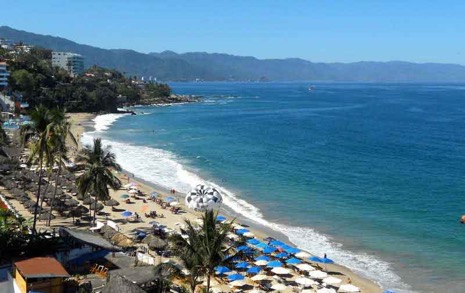
Puerto Vallarta, on Mexico’s Pacific Coast, has been an international beach resort for more than 50 years. Once a small fishing village, today the greater Vallarta area stretches for nearly 30 miles along the shores of Banderas Bay, one of the world’s largest bays. This area offers pure First-World living, with shopping, restaurants, and real estate at every price point; an international airport; and a large, international expat community. Beaches and a long malecón (esplanade) border large swaths of the city. But Puerto Vallarta offers so much to do—from zip-lining and horseback riding in the hills, to fine dining and recent film releases in town—that you’ll have plenty to do, even if you never put a toe in the water.
If you want big-city life with the beach a short distance away, there’s Mérida. Capital of the Yucatán Peninsula, this city of nearly a million residents lies about half an hour from the Yucatán Gulf Coast. Small villages dot this placid coast. This is where Mérida’s middle-class families have summered for generations. Today expats have joined them, but many towns still have a family-oriented feel. Don’t look for boutique shopping or dining here, but if you’re seeking a laidback beach life at still-low prices, you can find it here.
Historic Cities
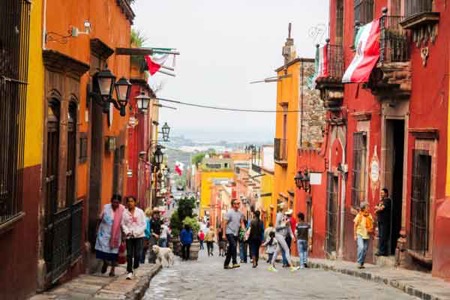
Not everyone wants to live on the beach…. If you prefer temperate weather and Spanish-colonial style, then Lake Chapala or San Miguel de Allende, both in central Mexico, may fit the bill. Lake Chapala has an enviably near-perfect climate—spring-like almost all year—and a large, diverse expat community. And being near Guadalajara, Mexico’s second-largest city, means easy access to its international airport and excellent medical facilities. San Miguel, about three hours north of Mexico City, is a beautifully preserved Spanish-colonial town that offers art galleries, gourmet restaurants, a wealth of arts and crafts, and a large expat community.
Places to Skip in Mexico
No country is perfect, and Mexico has gotten more than its share of knocks. But yes, some parts of Mexico should be avoided, while others are just not worth your time.
Some Mexican states bordering the U.S.
Notably Tamaulipas, Coahuila, and Chihuahua—have vast, empty interiors where you can be at the mercy of accidents and bad weather. If you’re looking to drive down into central Mexico or farther south (and many expats do), consider checking routes through other Mexican states like Nuevo León, Sonora, and Baja California.
Acapulco
Acapulco was once one of Mexico’s top beach resorts, but age and scattered violence has dimmed the city’s glitter. If you want to stay on the beaches of Acapulco’s home state, Guerrero, head north to Ixtapa-Zihuatanejo.
Tabasco
Finally, Tabasco may be a famous hot sauce, but the Mexican state is largely humid, low-lying land. It’s the boring, often wet stretch you’ll pass if you’re driving from central Mexico to the Yucatán Peninsula. Tabasco’s capital, Villahermosa, is a major business city, headquarters of Mexico’s oil industry and home to several museums. Take a quick look if you’re inclined…but with so many interesting places both north and south of it, you probably won’t want to linger.
San Miguel De Allende, Mexico
Retire in San Miguel de Allende
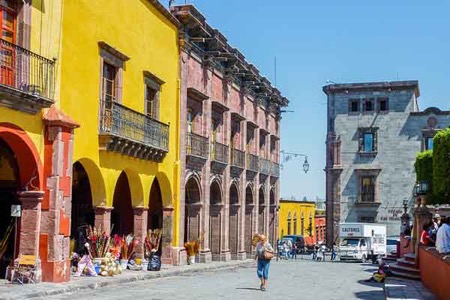
One of the country’s hidden charms can be found in its interior, about four-hour’s drive northwest of the capital, Mexico City. The town is called San Miguel de Allende, and it’s located in the Colonial Highlands region. It offers a lot of benefits: temperate climate, low cost of living, an active expat community, welcoming locals, charming local cultural traditions, and a focus on the arts.
The setting is beautiful. Its colonial centro is a UNESCO World Heritage site. So it is mandated that homes, churches, civic structures, businesses…just about every original structure…retain its historic, original appearance. And that is strictly-enforced here. Even signage for businesses is discrete. Narrow streets, cobblestone or flagstone, are lined with homes in shades of yellow, red, orange, and brown terracotta, barrel-tile roofs. It might be tough to drive a car here, but it’s certainly a pleasant place to take a long walk, exploring the architectural splendor that includes grand homes with wrought iron bars and imposing wooden doors, baroque churches with carved archways depicting religious scenes, and more.
Thanks to its beauty and peaceful atmosphere, along with all the other benefits, San Miguel is certainly no stranger to expats—they make up about 10% of the 125,000 residents in the wider metro area. These days the population swells during the North American winter, when Canadian, American, and European “snowbirds” flock to town for the great climate.
As you turn a corner you’ll more often than not come into plazas and parks filled with shady trees and benches. These are hives of activity with food vendors, couples strolling hand in hand, playing children, and chatting retirees. There is guaranteed to be at least one shoe shine stand.
Behind plain doorways and windows with wrought-iron bars are hidden treasures. Colonial homes are historic inside and out, although the renovated ones have updated electric and plumbing, as well as high-speed internet. Interior courtyards with gardens and fountains, intricate decorative tile work, vaulted ceilings with the original timbers…you’re living in history.
Because it’s in the high sierra, the air is crisp and clean. And the climate is temperate year-round, staying in the 70s F most days and cooling down at night to the 50s F. Only in January and February will you experience colder months, with comfortable days and dips close to freezing on the coldest nights.
There is also high quality and low cost medical care available. Well-regarded doctors, dentists, and medical clinics are located in town, with large hospitals and specialists available in the nearby city of Queretaro, about 45-minutes’ drive away.
The epicenter of life for expats and locals is El Jardin, the main plaza and park in front of the famous red gothic style church known as La Parroquia. In the colonnaded buildings surrounding the park are cafés and restaurants where you can enjoy a café con leche (coffee with milk) and people watching.
Lifestyle in San Miguel de Allende
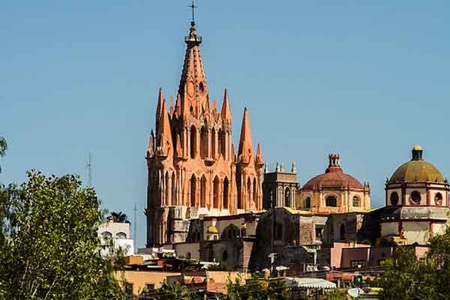
What calls so many expats to San Miguel in particular? The same reasons that the town’s first foreign residents came right after World War II. They were veterans who came to take art classes in local institutes—it was covered by the GI Bill. Since then it’s been a favorite destination of artists, musicians, and others interested in art and culture.
Today it has a thriving arts scene with live theater, lectures, book clubs, live music performances, foreign and independent films theaters…and more galleries showcasing modern and folkloric art than you can count. Whether you’re a participant or spectator, it’s a great scene for art lovers.
There are also great restaurants. The influence of tourism and the relatively large expat population means you can find everything from street tacos for about 75 cents and simple meals in local restaurants for a couple of bucks, to cuisine from around the world, including Italian, sushi, vegetarian, as well as gourmet options.
Real Estate in San Miguel de Allende
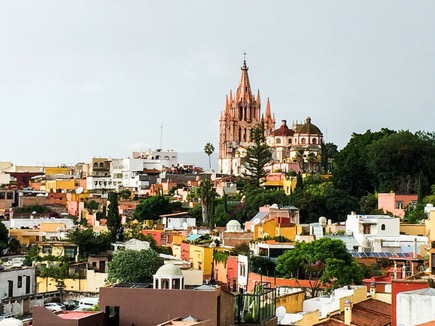
There are plenty of affordable real estate options in San Miguel de Allende. But the closer you are to the heart of the colonial centro, the plaza known as El Jardin, the higher the price. Expect to pay about $350,000 and up for a restored colonial home, with two or three bedrooms, in the best neighborhoods in town.
But go to the outskirts of the colonial zone, still in safe and nice areas, and you’ll pay much less. For example, a one-bedroom apartment will go for $169,000. From there it’ll still be a five to 10-minute walk to the restaurants and entertainment options and cultural activities in the historic area. Head to the outskirts of town, but still a 20-minute walk to downtown or a five-minute taxi ride (for $3), and you’ll find modern homes for bargain prices. Here you’ll easily find a three-bedroom home for around $200,000 and up.
Cost of Living in San Miguel de Allende
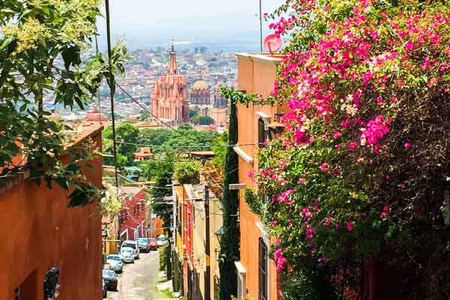
The low cost of living carries over to daily expenses and monthly bills as well. Rents start at about $800 per month for a two-bedroom apartment for a long-term lease. This will put you on the outskirts of the historic centro. Keep in mind that during “high season,” from January to April, it is very hard to find a monthly rental and prices do go up. If you’re interested in living in the city at that time of year, it’s best to reserve a place early.
Local markets offer fresh produce in a lively atmosphere at a low price. A retired couple could fill their fridge with fruits and veggies, plus meat and chicken, eggs…whatever they want, for about $25 a week. With the pleasant climate, there’s no need for air conditioning or heat, so electric bills are low.
Going out is cheap too. Even at “high end” restaurants you won’t break the bank. It’s hard to spend more than $40 to $50 per couple for a nice meal with wine and pre-dinner cocktails.
Here’s an example of a monthly budget for a couple living in San Miguel de Allende:
| Expense | U.S. $ |
| Rent (two-bedroom apartment) | $800 |
| Electricity | $50 |
| Gas & Water | $30 |
| Cell Phones (x2) | $40 |
| Groceries & Household Items | $300 |
| Mercado | $70 |
| Insurance | $100 |
| Internet | $60 |
| Streaming Media Accounts | $45 |
| Property Tax | $22 |
| Dining Out | $100 |
| Taxis, Buses | $40 |
| Monthly total: | $1,657 |
Editor’s Note: Think of it…moonlit fiestas, strolling mariachis, languid white-sand beaches, colonial towns set in the rugged Sierras, ancient Mayan pyramids rising from the misty Yucatan jungle… Mexico has it all: perfect climate, affordable living, not to mention mountains, beaches, deserts, and just about everything in between.
Discover everything Mexico has to offer and more in International Living Magazine. Subscribe today and save .
Discover the Pleasures of Strolling Colonial San Miguel de Allende
By Jason Holland
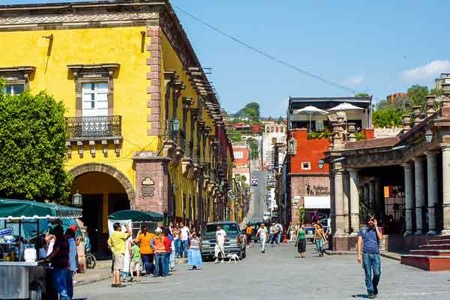
We walk a lot, in our new home of San Miguel de Allende. The narrow streets of the centro make navigating this highlands town in central Mexico by car, tough. And, since we can walk everywhere we want to go anyway, my wife, Liz, and our family just take to our feet.
Taxis and Ubers are cheap and easy if we don’t want to walk back after an afternoon in the historic district, especially when we’ve stopped in the market on the way home to buy some fruits and veggies—we can get too much to carry comfortably, for about $5. And besides, we don’t want our just-roasted rotisserie chicken ($4) to get cold. After an adjustment period to account for the higher elevation (6,000 feet) and all the hills, which left us out of breath, I feel like we’re in better shape since moving here from the coast.
Being on foot, you notice things you normally wouldn’t, too. Whenever you walk out your door in San Miguel de Allende and stroll down the street…you never know what you’re going to find. Thanks to strict regulations against garish signage for businesses, you usually have no idea what’s around you, until you walk past a window and look in or poke your head in an open doorway, or step into a courtyard. Coffee shops, restaurants, art galleries, spas…it’s all around you. If we find something cool, I make note of the street address, so I can find it again later.
Walking forces you to slow down, and really get to know the town—and not just because you’re navigating narrow sidewalks and cobblestone streets (always wear sturdy shoes). We also run into people we know all the time…and that’s usually an occasion to grab a café con leche or sit at a bench in a plaza to chat, while our kids play.
We’re living in history here, with centuries-old churches, civic buildings, convents, and monasteries…and festivals that have been going for hundreds of years, taking place every week. Just the other night, we heard drums booming down the road from our house…fireworks going off…and church bells tolling. We walked outside to find a parade honoring San Miguel Arcangel (the Archangel St. Michael), the patron saint of the town.
We’re gearing up now for “Day of the Dead” on Nov. 1 and 2—it’s said to be one of the best celebrations in Mexico of this national holiday.
Thanks to its location in the heart of Mexico, San Miguel de Allende, is a great home base for exploring nearby notable towns and villages. Dolores-Hidalgo, is the birthplace of Mexican independence, and hosts a huge celebration every year on Sept. 15 and 16…but any other day, it’s a quaint little village to stroll around, famous for its ice cream. Nearby Mineral de Pozos is a former silver-mining center. Once a virtual ghost town (and there are still plenty of majestic ruins), its reputation as an artists’ colony has grown in recent years
And you can’t forget Guanajuato, whose colonial center is in a narrow valley. This October, we plan to see at least some performances that are part of the Cervantino, a weeks-long arts festival, featuring international artists and performers from around the world.
Of course, since we live in one of the most developed parts of Mexico, I must admit that we also enjoy heading for trips to some of the big box stores and malls in Queretaro, a major metropolis of 1 million, about an hour’s drive away. My kids love the arcades, trampoline parks, and other fun stuff.
It’s like we have the best of both worlds—modern conveniences with plenty of historic charm.
Editor’s Note: Wherever you go in Mexico, the people will charm you, the natural beauty will seduce you, and the remarkably affordable cost of living will entice you to stay….Just like most of the destinations we tell our 103,000 subscribers about each month in the pages of International Living Magazine.
Join our community and whatever your dream may look like – start planning it today – armed with information from the experts.

